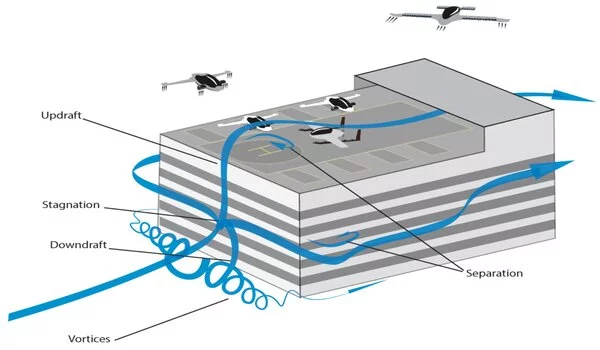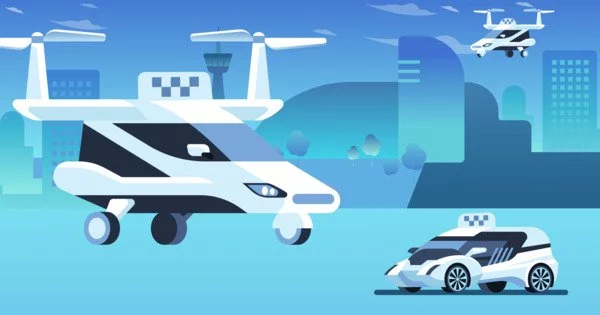The impact of city buildings on the future of air taxis is a legitimate concern. Air taxis, also known as urban air mobility vehicles, rely on the availability of urban landing and takeoff infrastructure. While they have the potential to revolutionize transportation by providing efficient and convenient aerial transportation, several challenges must be overcome before they can be widely adopted.
Although air taxis are expected to arrive in our cities in the near future, a new study warns that regulations will be required to address dangerous wind gusts around city buildings and other urban infrastructure. The air taxi market is almost ready to take off, with companies like Boeing, Hyundai, Airbus, and Toyota constructing fleets to transport commuters through the sky. Europe and the United States have both drafted new rules to allow air taxis to begin operations within the next decade, and Australia’s Civil Aviation Safety Authority (CASA) is expected to follow suit.
Recent studies have measured how sudden wind gusts from around city buildings and can destabilize aircraft, including a recent paper by RMIT University’s Uncrewed Aircraft Systems (UAS) Research Team.
Dr. Abdulghani Mohamed, the lead researcher and aerospace engineer who has studied wind gust dynamics for over a decade, believes that this aspect needs to be adequately addressed by regulation in Australia and elsewhere before we fill our city skies with air taxis and other drones.
These aircraft require powerful motors that can rapidly change the thrust generated by the propellers to quickly force the vehicle back on course, a process that requires more energy.
Dr. Abdulghani Mohamed
Strong wind gusts from around city buildings
Wind gusts pose a risk to low-flying aircraft because they land and take off at low speeds, according to Mohamed, with RMIT research revealing that sudden wind gusts can pose significant safety challenges for air taxis and drones in less than a second.
As a result, air taxis and drones will require more power to land or take off in cities than in airports or open spaces, he explained.
“These aircraft require powerful motors that can rapidly change the thrust generated by the propellers to quickly force the vehicle back on course, a process that requires more energy,” Mohamed of the School of Engineering explained.

Making our city skies safe
Regulations for Advanced Air Mobility (AAM) aircraft, such as future air taxis, are being developed globally, including in the United States and Europe. The RMIT team emphasizes the importance of weather frameworks in ensuring the safety and reliability of this new technology.
“Regulations and certification need to specifically address safe operation when traversing building flow fields,” Mohamed said. He contends that site-specific wind simulations and measurements are required to identify potentially hazardous areas.
“Along with determining the location of vertiports – where these vehicles will take off and land – we must also identify hazardous regions to avoid.” This will improve safety and reduce fleet interruption due to wind conditions,” Mohamed explained.
“In Australia, it is unclear whether this falls under the jurisdiction of CASA or the Bureau of Meteorology; however, air taxis will require weather information at much higher resolution and at much faster rates than is currently possible.” This is critical for flight planning. The margin for error will be much smaller than at airports, where large planes can withstand much stronger gusts. We won’t have that flexibility with city air taxis.”
Next steps
“Purpose-built vertiports mean we could integrate geometric design features to reduce hazardous flow conditions from occurring, and we are exploring this in our current research,” Mohamed said.
“Existing buildings can also be repurposed as vertiports but may require modifications to improve the aerodynamics near the landing pads. The effectiveness of such design features can be assessed through either scaled experiments in wind tunnels or through full-scale measurements. Extensive wind flow mapping at full scale will no longer be daunting in the future. We are continuing to develop our wind sensing drones – a swarm of drones instrumented with wind anemometers – to very accurately map around large infrastructure.”
The article ‘Gusts Encountered by Flying Vehicles in Close Proximity to Buildings’ appears in MDPI’s Drones. The recommendations could influence the regulation of vertiports, flight paths, and air taxi requirements in Australia and, potentially, around the world.
The researchers are continuing their investigation into wind gusts around buildings, with a focus on different building shapes that may reduce adverse effects. They are also continuing to investigate vehicle sensitivity to gusts and turbulence, as well as flight-stability technologies.
















